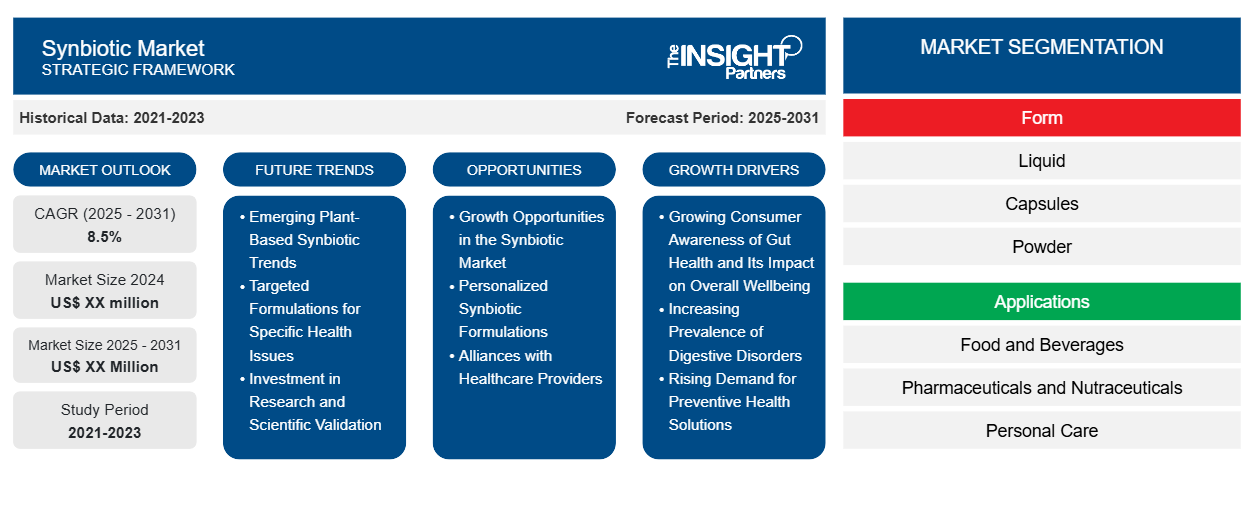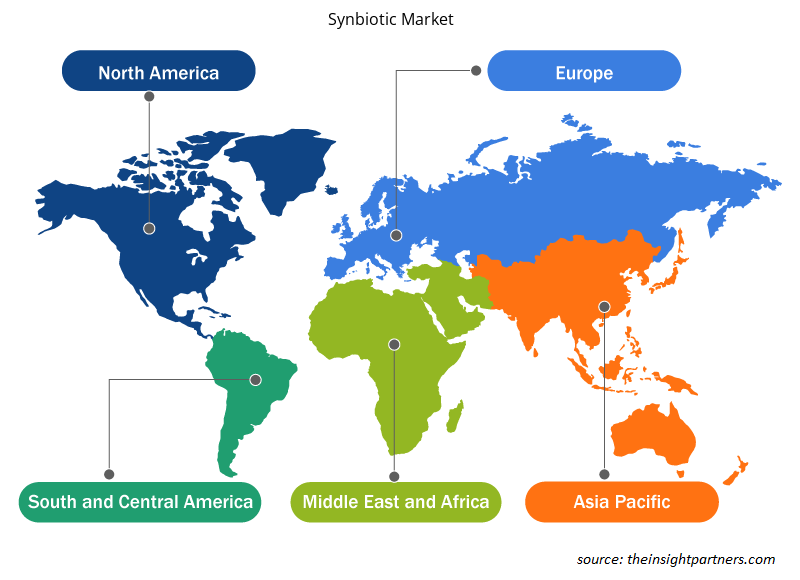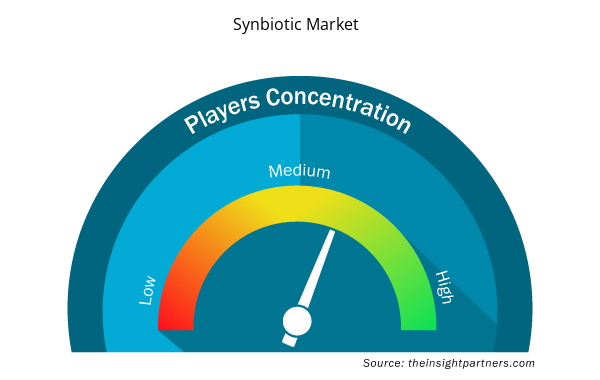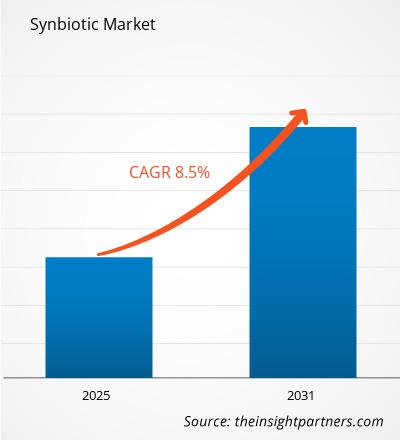The Synbiotic Market is expected to register a CAGR of 8.5% from 2025 to 2031, with a market size expanding from US$ XX million in 2024 to US$ XX Million by 2031.
The report is segmented by form (liquid, capsules, and powder). The report further presents an analysis based on the applications (food and beverages, pharmaceuticals and nutraceuticals, personal care, animal nutrition, and others). The report scope covers five regions: North America, Europe, Asia Pacific, Middle East and Africa, and South and Central America and key countries under each region. The global analysis is further broken-down at regional level and major countries. The Report Offers the Value in USD for the above analysis and segments.
Purpose of the Report
The report Synbiotic Market by The Insight Partners aims to describe the present landscape and future growth, top driving factors, challenges, and opportunities. This will provide insights to various business stakeholders, such as:
- Technology Providers/Manufacturers: To understand the evolving market dynamics and know the potential growth opportunities, enabling them to make informed strategic decisions.
- Investors: To conduct a comprehensive trend analysis regarding the market growth rate, market financial projections, and opportunities that exist across the value chain.
- Regulatory bodies: To regulate policies and police activities in the market with the aim of minimizing abuse, preserving investor trust and confidence, and upholding the integrity and stability of the market.
Synbiotic Market Segmentation
Form
- Liquid
- Capsules
- Powder
Applications
- Food and Beverages
- Pharmaceuticals and Nutraceuticals
- Personal Care
- Animal Nutrition
- Others
Customize This Report To Suit Your Requirement
You will get customization on any report - free of charge - including parts of this report, or country-level analysis, Excel Data pack, as well as avail great offers and discounts for start-ups & universities
Synbiotic Market: Strategic Insights

- Get Top Key Market Trends of this report.This FREE sample will include data analysis, ranging from market trends to estimates and forecasts.
Synbiotic Market Growth Drivers
- Growing Consumer Awareness of Gut Health and Its Impact on Overall Wellbeing: Over time more and more people are understanding the necessity of a healthy gut for their wellness as a whole. The real impact makes them more aware of how important it is for the digestive system, immune function, mental health as well as skin conditions. This increasing knowledge is what moves the great majority to seek such gut health products as synbiotics. Synbiotics combine probiotics and prebiotics to support the health of the intestines milk product.
- Increasing Prevalence of Digestive Disorders: The increasing prevalence of digestive disorders and health conditions associated with an imbalanced gut microbiome is evident. Research finds links between gut microbiome imbalances and conditions such as obesity, diabetes, and autoimmune diseases. As these issues become increasingly common, people are accessing the application of gut-supporting products like Synbiotics.
- Rising Demand for Preventive Health Solutions: There is an increasing demand for natural and preventive healthcare options due to consumers preferring natural remedies. Synbiotics are a natural way to boost gut health, thus attracting more consumers.
Synbiotic Market Future Trends
- Emerging Plant-Based Synbiotic Trends: Current synbiotic trends on the market relate to the newly emerging plant-based and vegan-friendly products, which are mirroring the changing consumer demand for healthier and more sustainable dietary choices. This is an appropriate trend as consumers increasingly make lifestyle choices, and gut health and general wellbeing are aligned.
- Targeted Formulations for Specific Health Issues: There is a major trend toward the development of specific synbiotic mixtures to focus on particular health issues. Manufacturers are increasingly looking to produce specific formulations related to issues such as digestive health, immune support, and mental well-being. The trend increases consumer awareness and gives impetus to the demand for specialty synbiotic products with a targeted benefit.
- Investment in Research and Scientific Validation: The synbiotic market is increasingly investing in Research and clinical trials to establish the validity of health claims and discover new formulations. An ever-growing requirement for scientific validation of products during their development process has been building consumer trust. Since such efforts are increasing the credibility of synbiotic products and expanding the doors to further innovations, they are definitely winning the game.
Synbiotic Market Opportunities
- Growth Opportunities in the Synbiotic Market: The synbiotic market presents significant growth opportunities in new product categories, excluding traditional dairy-based products. The participation of segments such as beverages, snacks, and dietary supplements will make synbiotics more accessible to a broad audience and realize diverse consumer preferences while enhancing broader access to synbiotic benefits in everyday diets.
- Personalized Synbiotic Formulations: Personalized synbiotic formulations, tailored to each individual's unique microbiome, will represent an unusual opportunity within the market. As an individual becomes more health-conscious, the attention toward these more targeted gut health products will be unusual. Customized products are associated with better efficacy, which encourages consumer loyalty and innovation within the synbiotic product lines.
- Alliances with Healthcare Providers: The synbiotic market may have a potential opportunity to form alliances with healthcare providers. Synbiotics integration into a medical treatment and therapy enhances the care of patients and promotes preventive health strategies for manufacturers. Additionally, the awareness and acceptance towards synbiotics as constituents of holistic well-being can be increased through the partnership between a manufacturer and healthcare professionals.
Synbiotic Market Regional Insights
The regional trends and factors influencing the Synbiotic Market throughout the forecast period have been thoroughly explained by the analysts at Insight Partners. This section also discusses Synbiotic Market segments and geography across North America, Europe, Asia Pacific, Middle East and Africa, and South and Central America.

- Get the Regional Specific Data for Synbiotic Market
Synbiotic Market Report Scope
| Report Attribute | Details |
|---|---|
| Market size in 2024 | US$ XX million |
| Market Size by 2031 | US$ XX Million |
| Global CAGR (2025 - 2031) | 8.5% |
| Historical Data | 2021-2023 |
| Forecast period | 2025-2031 |
| Segments Covered |
By Form
|
| Regions and Countries Covered | North America
|
| Market leaders and key company profiles |
Synbiotic Market Players Density: Understanding Its Impact on Business Dynamics
The Synbiotic Market market is growing rapidly, driven by increasing end-user demand due to factors such as evolving consumer preferences, technological advancements, and greater awareness of the product's benefits. As demand rises, businesses are expanding their offerings, innovating to meet consumer needs, and capitalizing on emerging trends, which further fuels market growth.
Market players density refers to the distribution of firms or companies operating within a particular market or industry. It indicates how many competitors (market players) are present in a given market space relative to its size or total market value.
Major Companies operating in the Synbiotic Market are:
- Chr. Hansen Holding A/S
- Danone S.A.
- Yakult Honsha Co., Ltd.
- Nestlé S.A.
- Probi AB
- DuPont
Disclaimer: The companies listed above are not ranked in any particular order.

- Get the Synbiotic Market top key players overview
Key Selling Points
- Comprehensive Coverage: The report comprehensively covers the analysis of products, services, types, and end users of the Synbiotic Market, providing a holistic landscape.
- Expert Analysis: The report is compiled based on the in-depth understanding of industry experts and analysts.
- Up-to-date Information: The report assures business relevance due to its coverage of recent information and data trends.
- Customization Options: This report can be customized to cater to specific client requirements and suit the business strategies aptly.
The research report on the Synbiotic Market can, therefore, help spearhead the trail of decoding and understanding the industry scenario and growth prospects. Although there can be a few valid concerns, the overall benefits of this report tend to outweigh the disadvantages.
- Historical Analysis (2 Years), Base Year, Forecast (7 Years) with CAGR
- PEST and SWOT Analysis
- Market Size Value / Volume - Global, Regional, Country
- Industry and Competitive Landscape
- Excel Dataset



Report Coverage
Revenue forecast, Company Analysis, Industry landscape, Growth factors, and Trends

Segment Covered
This text is related
to segments covered.

Regional Scope
North America, Europe, Asia Pacific, Middle East & Africa, South & Central America

Country Scope
This text is related
to country scope.
Frequently Asked Questions
DSM, Probi AB, Evonik Industries AG, HeiQ Materials AG, Sabinsa, A and B Ingredients Inc, Archer Daniels Midland Co, Probiotical SpA, Chr. Hansen AS, and Synbiotic Health
The Synbiotic Market is estimated to witness a CAGR of 8.5% from 2023 to 2031
The major factors driving the synbiotic market are:
1. Growing Consumer Awareness of Gut Health and Its Impact on Overall Wellbeing.
2. Increasing Prevalence of Digestive Disorders.
Form (Liquid, Capsules, and Powder) and Applications (Food and Beverages, Pharmaceuticals and Nutraceuticals, Personal Care, Animal Nutrition, and Others)
The report can be delivered in PDF/Word format, we can also share excel data sheet based on request.
On the basis of geography, the synbiotic market is classified into North America, Europe, Asia Pacific, Middle East and Africa, and South and Central America
Trends and growth analysis reports related to Food and Beverages : READ MORE..
The List of Companies
1. BIOMIN Holding GmbH
2. Daflorn Ltd.
3. Danone S. A.
4. Diamond V
5. General Mills Inc
6. Pfizer Inc.
7. Probiotical S. p. A.
8. Sabinsa Corporation
9. Seed Health, Inc.
10. UAS Laboratories Inc.

 Get Free Sample For
Get Free Sample For